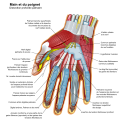Súbor:Wrist and hand deeper palmar dissection-numbers.svg

Veľkosť tohoto PNG náhľadu tohoto SVG súboru: 474 × 600 pixelov. Iné rozlíšenia: 190 × 240 pixelov | 379 × 480 pixelov | 607 × 768 pixelov | 809 × 1 024 pixelov | 1 619 × 2 048 pixelov | 555 × 702 pixelov .
Pôvodný súbor (SVG súbor, 555 × 702 pixelov, veľkosť súboru: 207 KB)
História súboru
Po kliknutí na dátum/čas uvidíte ako súbor vyzeral vtedy.
| Dátum/Čas | Náhľad | Rozmery | Používateľ | Komentár | |
|---|---|---|---|---|---|
| aktuálna | 17:15, 1. jún 2015 |  | 555 × 702 (207 KB) | Perhelion | optimize image |
| 11:42, 8. júl 2012 |  | 555 × 702 (399 KB) | Wilfredor | optimize image | |
| 21:11, 13. január 2009 |  | 555 × 702 (817 KB) | Wilfredor | {{Information |Description= |Source= |Date= |Author= |Permission= |other_versions= }} | |
| 16:37, 16. október 2008 |  | 555 × 702 (815 KB) | Wilfredor | {{Information |Description= |Source= |Date= |Author= |Permission= |other_versions= }} | |
| 19:33, 23. júl 2008 |  | 770 × 767 (822 KB) | Bibi Saint-Pol | {{Created with Inkscape}} == {{int:filedesc}} == {{Information |Description= {{en|The hands (med./lat.: manus, pl. manūs) are the two intricate, prehensile, multi-fingered body parts normally located at the end of each arm of a human or other primate. Th |
Použitie súboru
Na tento súbor odkazujú nasledujúce 2 stránky:
Globálne využitie súborov
Nasledovné ďalšie wiki používajú tento súbor:
- Použitie na af.wikipedia.org
- Použitie na ar.wikipedia.org
- Použitie na az.wikipedia.org
- Použitie na bjn.wikipedia.org
- Použitie na bn.wikipedia.org
- Použitie na br.wikipedia.org
- Použitie na ce.wikipedia.org
- Použitie na crh.wikipedia.org
- Použitie na cv.wikipedia.org
- Použitie na da.wikipedia.org
- Použitie na de.wikipedia.org
- Použitie na en.wikipedia.org
- Wikipedia:Featured picture candidates/Wrist and hand deeper palmar dissection-en.svg
- Wikipedia:Featured picture candidates/April-2009
- User:Madhero88/Medicalg
- Wikipedia:WikiProject Anatomy/Resources
- Wikipedia talk:WikiProject Anatomy/Archive 9
- User talk:Rhododendrites/Reconsidering FPC on the English Wikipedia
- Použitie na es.wikipedia.org
- Použitie na fa.wikipedia.org
- Použitie na ff.wikipedia.org
- Použitie na fr.wikipedia.org
- Použitie na hr.wikipedia.org
- Použitie na hu.wikipedia.org
- Použitie na id.wikipedia.org
- Použitie na incubator.wikimedia.org
- Použitie na iu.wikipedia.org
- Použitie na ko.wikipedia.org
- Použitie na lbe.wikipedia.org
- Použitie na lb.wikipedia.org
- Použitie na lt.wikipedia.org
- Použitie na ms.wikipedia.org
- Použitie na nia.wiktionary.org
- Použitie na os.wikipedia.org
- Použitie na pl.wikipedia.org
- Použitie na pt.wikipedia.org
Zobraziť ďalšie globálne použitie tohto súboru.







